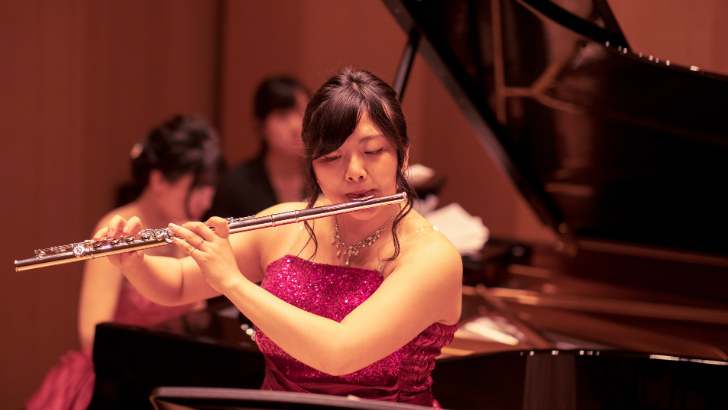
The Western concert flute is a reedless woodwind instrument made of metal or wood, known for its bright, clear tone and wide range.
It is commonly used in symphony orchestras, concert bands, chamber music ensembles, and solo performances.
The flute is also prevalent in various musical genres including classical, jazz, folk, and contemporary music across the globe.
Detailed Instrument Description
| Instrument Name | Western Concert Flute |
| Instrument Family | Woodwind |
| Alternative Names | The Western concert flute is often simply referred to as the “flute.” In different languages, it might be called “flauta” (Spanish), “flûte” (French), or “Flöte” (German). |
| Geographical Presence | The Western concert flute is played worldwide, being a fundamental part of Western classical music traditions. It is a staple in symphony orchestras, wind ensembles, solo performances, and various other musical genres across Europe, the Americas, Asia, and beyond. |
| Instrument Classification | The Western concert flute falls under the Hornbostel-Sachs classification system as 421.121.12, identifying it as an edge-blown aerophone. This system classifies musical instruments based on how they produce sound, with the flute classified as an aerophone where sound is produced by a vibrating column of air. |
| Unique Features | The Western concert flute is known for its bright, clear, and penetrating sound. It has a cylindrical body with a headjoint, body, and footjoint, and is equipped with a system of keys that cover the holes. The flute’s ability to play rapid passages and its wide dynamic range make it a versatile instrument. |
| Sound Characteristics | The Western concert flute produces a bright, clear, and resonant sound with a wide dynamic range. It can produce both soft, airy tones and loud, piercing notes. The instrument is known for its agility and ability to play fast, intricate passages. |
| Typical Music Genres | The Western concert flute is primarily used in classical music, including orchestral, chamber, and solo repertoire. It is also found in jazz, contemporary, and popular music, as well as in various world music traditions. |
| Components | Headjoint, Body, Footjoint, Keys, Lip Plate, Embouchure Hole |
| Construction | The Western concert flute is traditionally made of metal, such as silver, gold, or nickel, though some student models are made of plated brass. The body consists of three main parts: the headjoint, body, and footjoint. The keys are typically made of metal and are covered with pads to create an airtight seal over the holes. |
| Size and Weight | The size of the Western concert flute typically ranges from 67 to 72 centimeters (26 to 28 inches) in length. The weight varies between 300 to 600 grams (0.7 to 1.3 pounds), depending on the materials used. |
| Variations and Customizations | Variations of the Western concert flute include different materials, key configurations, and additional keys for extended range. Customizations might include engraved or inlaid designs, different types of headjoints for varied sound quality, and ergonomic key adjustments. |
| Instrument History | The Western concert flute has a history dating back to ancient times, with its modern form evolving during the Baroque period. Theobald Boehm, a 19th-century German flute maker, made significant improvements to the design and key mechanism, resulting in the Boehm system flute that is standard today. The flute has played a crucial role in orchestral, chamber, and solo music for centuries. |
| Similar Types of Instrument | Piccolo, Alto Flute, Bass Flute |
| Playing Technique | The flutist blows across the embouchure hole to produce sound, using their fingers to press the keys and cover the holes to change pitches. Proper breath control, finger technique, and embouchure are essential for producing a clear and controlled sound. Techniques such as vibrato, trills, and flutter-tonguing add expression to the music. |
| Notable Composers | Wolfgang Amadeus Mozart, Carl Philipp Emanuel Bach, Claude Debussy |
| Famous Works | Mozart’s “Flute Concerto No. 1,” Bach’s “Flute Sonata in E minor,” Debussy’s “Syrinx” |
| Maintenance | Regular maintenance includes cleaning the instrument after playing, oiling the key mechanisms, and occasionally replacing pads and corks. The flute should be stored in a case to protect it from damage and environmental changes. |
| Learning Difficulty | Moderate to high; requires coordination and dexterity to manage breath control, finger positions, and embouchure. Learning proper hand techniques, breath support, and music reading are essential for effective playing. |
| Prominent Players | James Galway, Jean-Pierre Rampal, Emmanuel Pahud |
| Notable Performances | Notable performances include concerts by prominent flutists at major venues and festivals worldwide, such as the BBC Proms, Carnegie Hall, and the National Flute Association Convention. |
| Famous Orchestras/Bands | Prominent ensembles featuring the Western concert flute include the Berlin Philharmonic, the London Symphony Orchestra, and the Boston Symphony Orchestra. |
| Price Range | Western concert flutes range from $500 to $10,000 or more, depending on the craftsmanship, materials, and features. Beginner models start around $500, while professional models with custom features can exceed $10,000. |
| Interesting Facts | 1. The Western concert flute is one of the oldest musical instruments, with origins dating back over 40,000 years. 2. Theobald Boehm’s development of the modern flute in the 19th century revolutionized flute playing and design. 3. The flute is the highest-pitched instrument in the woodwind family. 4. The famous flutist James Galway is often referred to as “The Man with the Golden Flute” because of his gold flute. 5. The flute is used in a wide variety of music genres, from classical to jazz to pop, showcasing its versatility. |
If you would like to learn more facts about the amazing world of musical instruments, visit our homepage at worldofmusiclality.com or click the links below to explore the rest of our site.







